
If you are a new user and have been using Ubuntu for a few days or weeks, you might be wondering how to update your Ubuntu system for security patches, bug fixes and application upgrades.
Updating Ubuntu is incredibly simple. I am not exaggerating. It’s as simple as running two commands:
sudo apt update
sudo apt upgradeActually, there are two ways you can update your Ubuntu system:
- Update Ubuntu via the command line
- Update Ubuntu using the Software Updater GUI tool
Let me give you more details. Please note that this tutorial is valid for Ubuntu 20.04, 22.04, or any other version. The command line method is also valid for Ubuntu-based Linux distributions, like Linux Mint, Linux Lite, elementary OS, etc.
Method 1: Update Ubuntu via the Command Line
First, open the terminal in Ubuntu desktop. You can find it in the menu, or use the Ctrl+Alt+T keyboard shortcut. If you are logged on to an Ubuntu server, you already have access to a terminal.
In the terminal, you have to use the following command:
sudo apt update && sudo apt upgrade -y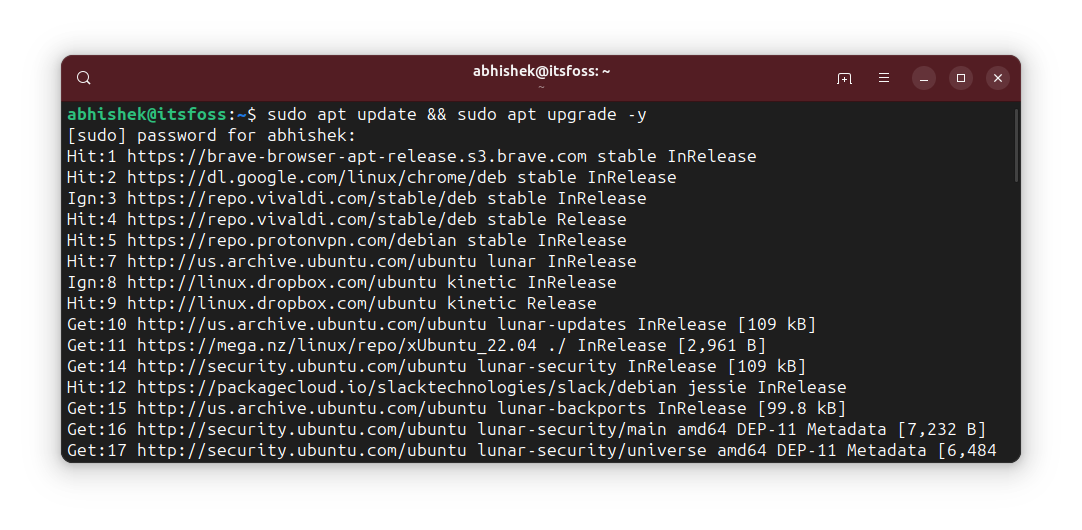
See, how easy it is to update Ubuntu from the terminal? Now let me explain the above command.
It’s actually not a single command; it’s a combination of two commands. The && is a way to run multiple commands in Linux in a way such that the second command runs only when the previous command ran successfully.
The “-y” in the end automatically enters “yes” when the command “apt upgrade” ask for your confirmation before installing updates.
Note that you can also use the two commands separately, one by one:
sudo apt update
sudo apt upgradeIt will take a little longer because you have to wait for one command to finish and then enter the second command.
Explanation: sudo apt update
This command updates the local database of available packages. If you don’t run this command, the local database won’t be updated and your system will not know if there are any new versions of packages available.
This is why, when you run the “sudo apt update” command, you’ll see lots of URLs in the output. The command fetches the package information from the respective repositories (the URLs you see in the output).
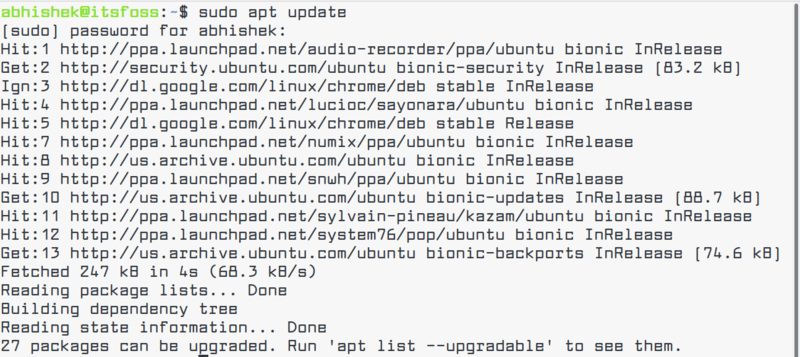
At the end of the command, it tells you how many packages can be upgraded. You can see these packages by running the following command:
apt list --upgradableExplanation: sudo apt upgrade
This command matches the versions of installed packages with the local database. It collects all of them, and then it will list those packages that have a newer version available. At this point, it will ask if you want to upgrade the installed packages to the newer version.
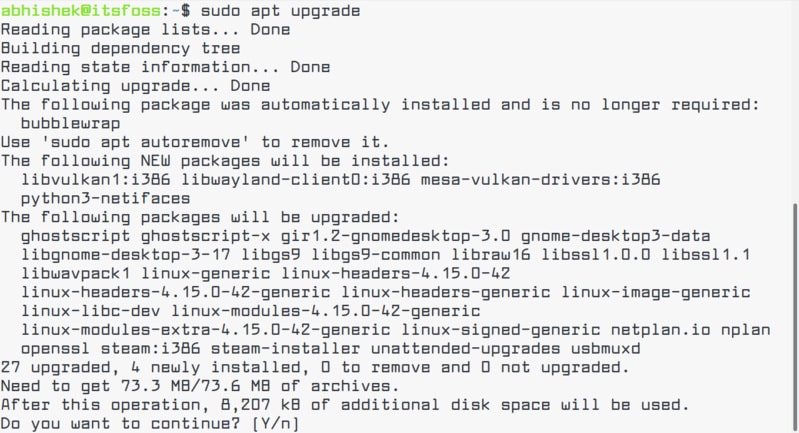
You can type “yes,” or “y,” or just press enter to confirm the installation of updates.
So the bottom line is that “sudo apt update” checks for the availability of new package versions, while “sudo apt upgrade” actually installs the new versions.
The term update might be confusing, as you might expect the “apt update” command to update the system by installing new software, but that’s not how it works.
Method 2: Update Ubuntu via the GUI [For Desktop Users]
If you are using Ubuntu as a desktop, you don’t have to go to the terminal to update the system. You can still use the command line, but it’s optional for you.
In the menu, look for “Software Updater” and run it.

It will check if there are updates available for your system.

If there are updates available, it will give you the option to install the updates.
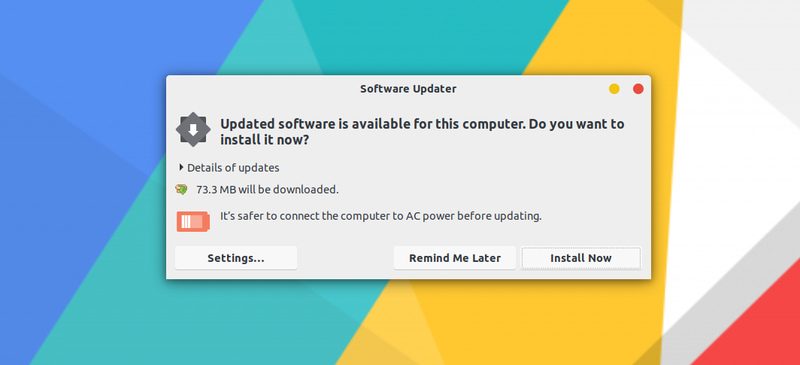
Click on “Install Now.” It may ask for your password.

Once you enter your password, it will start installing the updates.
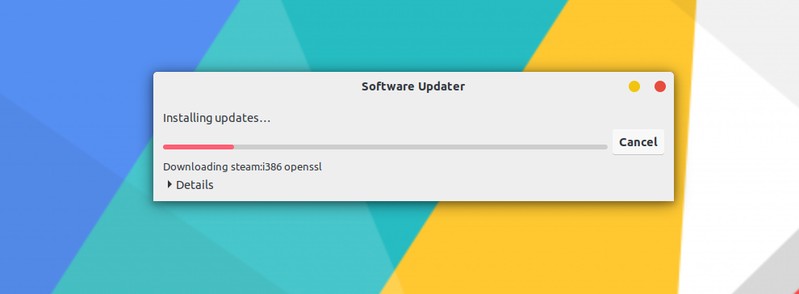
In some cases, you may need to reboot your Ubuntu system for the installed updates to work properly. You’ll be notified at the end of the update if you need to restart the system.

You can choose to restart later if you don’t want to reboot your system straightaway.

Tip: If the software updater returns an error, you should use the command “sudo apt update” in the terminal. The last few lines of the output will contain the actual error message. You can then search on the internet for that error and fix the problem.
A few things to keep in mind about updating Ubuntu
You just learned how to update your Ubuntu system. If you are interested, you should also know these few things relating to Ubuntu updates.
Cleaning up after an update
After an update, your system may have some unnecessary packages that are no longer required. You can remove such packages and free up some space by using this command:
sudo apt autoremoveLive patching the kernel in Ubuntu Server to avoid rebooting
In the case of Linux kernel updates, you’ll have to restart the system after the update. This can be a problem if you don’t want downtime for your server.
The live patching feature allows for the patching of the Linux kernel while it is still running. In other words, you don’t have to reboot your system.
If you manage servers, you may want to enable live patching in Ubuntu.
Ubuntu version upgrades are different from package upgrades
The update methods discussed here keep your Ubuntu install fresh and updated. It doesn’t cover OS version upgrades (for example, upgrading Ubuntu 16.04 to 18.04).
Ubuntu version upgrades are an entirely different thing. They involve updating the entire operating system core. You’ll need to make proper backups before starting this lengthy process.
Conclusion
I hope you liked this tutorial on updating the Ubuntu system and that you learned a few new things.
If you have any questions, please feel free to ask. If you are an experienced Linux user and have some tips that can make this tutorial more useful, please share them with the rest of us.

